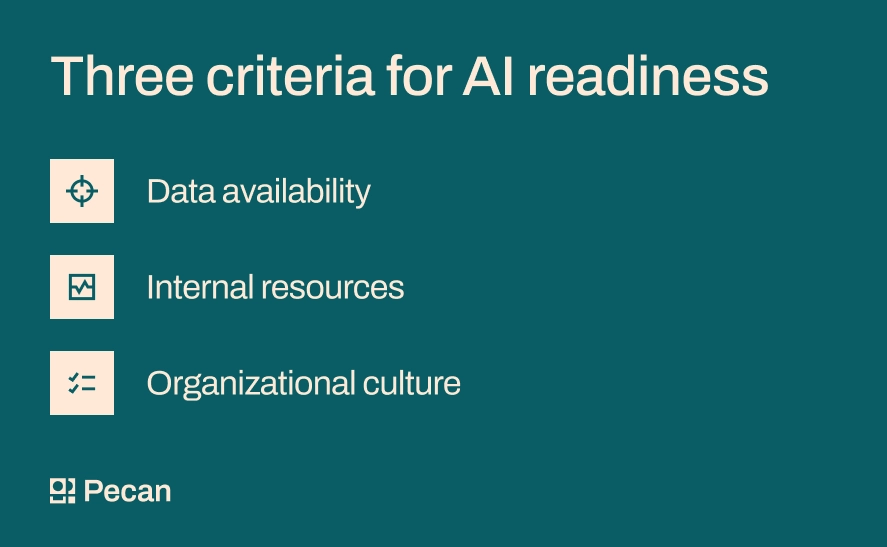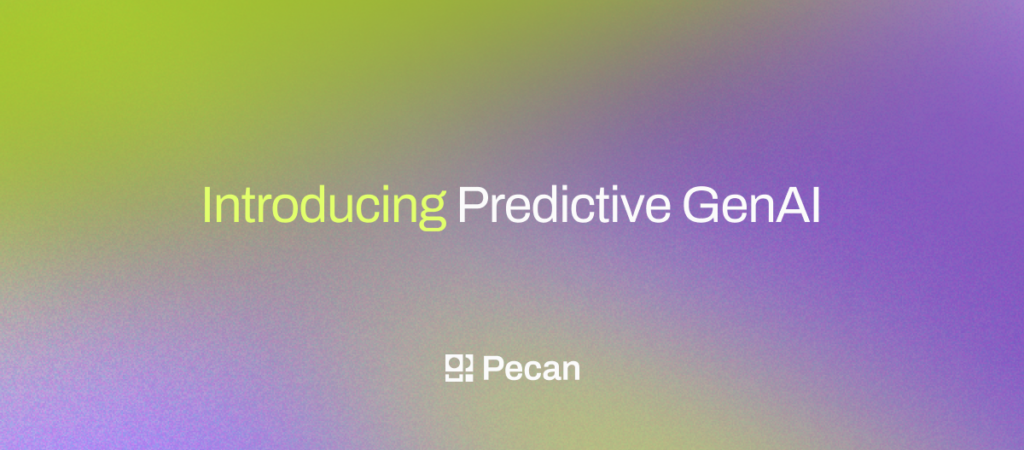In a nutshell:
- AI can automate up to 70% of existing workers' jobs, but organizations face challenges in adopting predictive analytics.
- Predictive AI goes beyond descriptive analytics, offering nuanced conclusions about the future.
- Predictive analytics offers benefits like forecasting future outcomes, competitive advantage, and increased performance.
- To start predictive modeling, evaluate data availability, internal resources, and organizational culture.
Many organizations' first inclination when implementing AI is to automate work and, in turn, lighten employees' workloads. McKinsey suggests AI can automate up to 70% of many existing workers’ jobs — that is, those tedious, manual tasks that eat up workers' time and keep analysts from more strategic analysis.
But AI isn’t just an optimizer. It can perform tasks that are generally outside the scope of everyday analytics. Predictive analytics uses machine learning and vast amounts of data to help you make informed decisions about the future — but you can’t leverage its predictive power if you never implement it.
In this article, we highlight the difficulties organizations face when adopting AI and predictive analytics. We’ll also look at some ways you can start using predictive AI for immediate ROI — and how Pecan can help you take your career to the next level via a low-code Predictive GenAI platform.
Challenges with applying predictive AI
Like a catered lunch, AI has burst into offices at rapid speed, and departments are scrambling for budget and their share of these new tools. Chances are, you and your team have been working furiously in recent months to get up to speed on the fundamentals of AI and discover which solutions are best for your tech stack. But you’ve also likely faced one or both of these limiting factors:
Uncertainty about how to use AI
For decades, data analysts have been making sense of historical data to understand the past — otherwise known as descriptive analytics. These insights reveal statistically significant ways of interpreting the past, which are used to inform decisions about the future.
But what happened in the past doesn’t necessarily dictate what will happen in the future. In other words, history doesn’t always repeat itself. Economic factors, customer preferences, and technology are transient and fickle. AI is capable of more than supporting descriptive analytics and automating manual tasks, but when organizations don’t take the time to completely understand its applications, they lessen their return on investment.
Here’s a quick breakdown: Predictive AI models don’t just observe broad patterns of the past — they reach nuanced conclusions about the future using large volumes of data and machine learning algorithms. However, it does take time to understand the broad and varied applications of predictive analytics across teams and use cases.
Once you understand how to apply predictive analytics, you’ll need to create a culture that wants to use it.
Hesitation around AI adoption
The primary limiting factor in predictive AI applications is culture. Organizations may have cultures that make innovating and getting creative with new tools difficult. After all, there’s work to be done and set ways of going about that work.
Going against the grain takes courage and a creative vision.
Trying out new approaches to analytics can feel inefficient at first. After all, learning a new tool takes time. As with most AI tools, there’s a low floor and a high ceiling. Companies with rigid cultures may not even be aware of the breadth of AI applications available to them.
When your culture emphasizes innovation, though, you can expect extremely positive results. Exploration and questioning lead to creative applications.
To accomplish this, we recommend creating a safe “sandbox” environment where you and your team can experiment with AI tools and non-critical data. What efficiencies and new use cases can you create? What can you create together?
Once AI is part of company culture, it will likely improve the culture itself. MIT published a white paper on AI’s powerful impact on culture, noting that it enhanced job efficacy and improved company morale by helping workers accomplish more small tasks.
The benefits of predictive analytics
Sticking to traditional descriptive data analytics methods feels sturdy and reliable. It’s the bedrock of all modern analytics. But once you’re familiar with the applications of predictive analytics, you’ll be eager to incorporate it into your analytics arsenal. Here are a few reasons to consider adopting predictive AI, including:
- Forecasting future outcomes. Using historical data, statistics, and machine learning models, you can generate accurate predictions of future events, using the data you’ve used to make sense of the past. You can get incredibly granular and understand customer patterns in a deeper way, predicting anything from which customers are most likely to churn to which products to develop.
- Competitive advantage. Organizations that aren’t applying the latest AI technologies are falling behind. Those who do take advantage of AI can expect a 6-8% revenue increase due to increased productivity.
When you know what products will resonate with your audience or what your inventory demands will be down the road, you can quickly increase your AI return on investment. (Some businesses have seen AI investment returns at levels as high as 250%.)
3. Increased performance. Integrating AI is an investment of time and money. With richer data comes better decisions, and predictive AI has been shown to improve performance across a variety of outcomes, such as demand forecasting, churn reduction, and marketing campaign optimization.
Low-code Predictive GenAI tools like Pecan have an even higher return, as you can build models in minutes via a chat-based interface that helps you isolate your business problem and quickly generate SQL. And because Pecan is so easy to use, the upfront time investment is low. With only a quick conversation, you can have a predictive model built to help you make better decisions across the board.
4. Increased productivity. Building, deploying, and fine-tuning a model that would take days or weeks can now be finished in minutes, giving you more time to focus on decision-making and problem-solving.
Is your organization ready to start predictive modeling?
Now that you know the benefits of predictive analytics, it’s important to assess whether or not your organization is ready to apply predictive AI tools.
AI readiness criteria to consider
Here are three criteria we suggest evaluating:
Data availability
While predictive models assess a future scenario, they still use historical data to reach conclusions. If your organization has substantial organized data for your model to draw upon, you may be a great candidate for using predictive AI.
You’ll also need the data to be relevant. For example, if you’d like to design a model that predicts churn, you’ll need relevant historical data about customers who have stopped shopping with you.
If your organization is brand new and, therefore, lacks historical data or hasn’t been tracked, you’ll need to collect data first. To use Pecan, you’ll need at least 1,000 rows of data.
The good news is that, depending on the predictive AI tool you use, you may not need to worry too much about data preparation. For example, Pecan’s Predictive GenAI platform automates the cleaning, preparation, and blending of data for you, so your data is ready to fuel your model without demanding hours of manual work.
Internal resources
Applying predictive models to your organization’s data requires more than data access. You’ll need to ensure you have adequate personnel, budget, time, and employee availability to acquire and implement new AI technology.
Culture
Finally, as discussed earlier, you’ll need to ensure that your organization has a culture willing to experiment with new tools and techniques. Is your culture open to using AI in their day-to-day work? If not, you may need to start there.
Other predictive AI use cases
Looking for more inspiration?
Ways to generate ideas for AI opportunities in your organization
Here are a few more resources you can look into to help brainstorm applications for predictive modeling within your organization.
- Read industry news about AI applications and successes from resources like TechCrunch, VentureBeat, and Gartner.
- Explore data professionals’ stories on LinkedIn and company tech blogs. At Pecan, we’ve written a few different guides to AI applications, including one for data analysts and one for data leaders.
- Navigate through customer stories from solution providers. Reading company case studies is a great way to understand how organizations apply AI tools. Read about how Pecan has revolutionized demand forecasting at CAA and improved email marketing at Hydrant.
- Look at your organization’s business objectives and brainstorm with your teams about how applying AI can help you get there. If you’re looking to lower churn this quarter, a predictive model, for example, could be a great asset.
- Collaborate within your organization on AI applications. Different departments will offer different approaches to integrating artificial intelligence and predictive analysis. Put your heads together to come up with some powerful, interdepartmental ways to apply AI tools in your organization.
Predict the future today
Pecan makes it simple to incorporate the benefits of predictive modeling within your organization. When you have an idea of what you want to predict, accompanied by a relevant data source, Pecan’s Predictive Chat can help you pinpoint and define a usable predictive question.
Then, the tool applies your data and creates a model designed just for your organization. It’s quicker than ever to tap into the power of predictive analysis.
Ready to learn more? Our team will walk you through the tool and answer any questions you have about how Pecan can improve your company’s outcomes. Schedule a demo today.
If self-learning is more your style, sign up for a free 7-day trial and start building predictive models in minutes.






